#usda hardiness zones
Text
I don't really have a USDA hardiness zone because those numbers are representative of comparative annual minimum temperatures. This isn't as meaningful here. I think pretty much all of our country would be covered by about USDA hardiness zones 7–12... it's a warm place, overall. I'm not usually worried about plants living through the cold months, but I do get worried about how they're gonna go in a serious heat wave.
Today I learnt about the practice of bringing lavender and rosemary (and I'm sure others) indoors for winter, which is evidently advised in some places where it gets really cold, and which I've never heard of for what, here, seem like very (very) resilient perennials.
It must be such a different experience to be growing stuff in places where you get a lot of snow and hard frost?
On the one hand, there's a well defined growing season and you have that structure as a framework for planning what you do. I can watch my plants struggle along all winter if I like (and then get mad at myself when they don't grow well in their overnight chills and low daily sunlight.)
On the other hand, perennial plants become annuals in other places, and late or early frosts can really sour the whole year. Hmm.
7 notes
·
View notes
Text
LINK FEST: 28 NOVEMBER 2023
Links that may or may not be related to gardens, food, travel, nature, or heterotopias and liminal spaces but probably are. Sources in parentheses.
essay/list: A New Kind of Bucket List: A passport to the world within (Andrea Gibson/Things That Don’t Suck). I’ve never understood the other kind of bucket list, compiling experiences by going places and doing external activities, though I enjoy…

View On WordPress
#Andrea Gibson#bucket list#credit scores#credit security#fruit#hardiness map#inner world#link fest#linkfest#links#oranges#psyche#roadsigns#signs#USDA hardiness zones
0 notes
Note
What state/region do you live in? Asking to know where the flowers are naturally growing :)
I am in USDA hardiness zone 8b! Most of my pictures are from Oregon or Washington in the USA Pacific Northwest.
3 notes
·
View notes
Text
USDA's plant hardiness zone map shows half the country has shifted : NPR
1 note
·
View note
Text
Plant Hardiness Zone Map Updated
The United States Department of Agriculture has released an updated version of its Plant Hardiness Zone Map. The map is based on data from Oregon State University's PRISM Climate Group, and it reflects a shift towards warmer temperatures across the country.
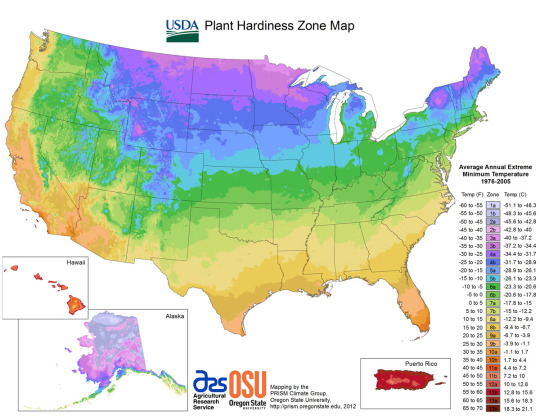
What is the Plant Hardiness Zone Map?
The Plant Hardiness Zone Map is a tool that gardeners and growers use to determine which plants are most likely to survive in their area. It is based on the average annual extreme minimum winter temperature, and it divides the country into 13 zones.
What are the key changes in the new map?
The new map is about 2.5 degrees Fahrenheit warmer than the 2012 map. This shift has resulted in about half of the country shifting to a warmer half zone, and half remaining in the same half zone. The central plains and Midwest have seen the most warming, while the southwestern U.S. has seen very little.
Zone 10a has been expanded to include parts of Texas and Louisiana, and Zone 11a has been expanded to include parts of California and Arizona.
Zone 12b has been expanded to include parts of Florida and Hawaii.
How can I find my plant hardiness zone?
Gardeners and growers can enter their zip code at planthardiness.ars.usda.gov to find their plant hardiness zone.
#Plant Hardiness Zone Map#USDA#Gardening#climate#climate crisis#Climate Change#Plant Adaptation#Gardening Community#usa news
1 note
·
View note
Text
Large Trees for Large Zone 7 Landscapes
Need help choosing a massive tree species for your large landscape? Knowing which tree species grow to larger proportions will help you fill vast areas of your landscape with shaded recreational areas.

thetreecareguide.com gathered species, planting, and care information for some of the more massive trees hardy to large zone 7 landscapes.
1. Weeping Willow (Salix babylonica)
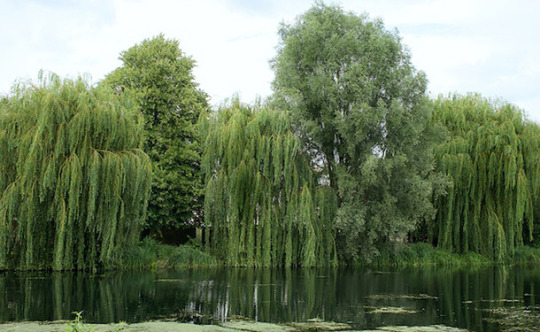
Weeping willows are recognized for their long, drooping branches and delicate leaves. They are typically found near fresh-water sources, as they have a strong affinity for moisture and thrive in damp soil. The weeping willow’s growth rate is fast, with new growth appearing each year. They can reach a mature size of 40 to 50 feet in height and spread, with a broad canopy that provides significant shade.
Weeping willows are hardy in USDA zones 6 through 8 and are easy to care for. They require consistent moisture to thrive, so they should be watered regularly. This tree species benefits from fertilization in the spring and pruning in the winter to maintain shape and encourage healthy growth. The weeping willow is a stunning addition to any large landscape and offer a peaceful, calming presence with their gentle sway in the breeze.
2. Ginkgo Biloba (Ginkgo biloba)
Ginkgo Biloba trees or Maidenhair trees are a unique and ancient species that can live for over a thousand years. They are easily recognized by their fan-shaped leaves turning bright yellow in the fall. These trees have a moderate growth rate and can reach a mature size of 80 feet high and a 50-foot spread. They are hardy in USDA zones 3 through 8 and are tolerant of various soil types as long as they are well-drained.
Ginkgo Biloba trees require minimal care and maintenance, ideal for low-maintenance landscapes. They prefer full sun to partial shade and should be watered regularly. They do not require fertilization, but occasional pruning will help maintain their shape and promote healthy growth. Ginkgo Biloba trees are prized for their medicinal properties (the foliage is believed to have beneficial effects on memory and cognition).
3. American Beech (Fagus grandifolia)
American Beech trees are a beautiful and stately deciduous species native to eastern North America. They have a slow to moderate growth rate and can reach a mature size of 70 to 80 feet in height and spread. They are hardy in USDA zones 3 through 9 and prefer well-drained soil rich in organic matter.
Beech trees need minimal care and maintenance once established. They prefer partial shade to full sun and should be watered regularly. They thrive from an annual compost application around the tree’s base. Pruning is typically only necessary to remove dead or diseased branches. Beech trees are highly valued for their attractive foliage, which turns a golden brown in the fall. They are also an important food source for birds and small mammals.
4. Southern Magnolia (Magnolia grandiflora)
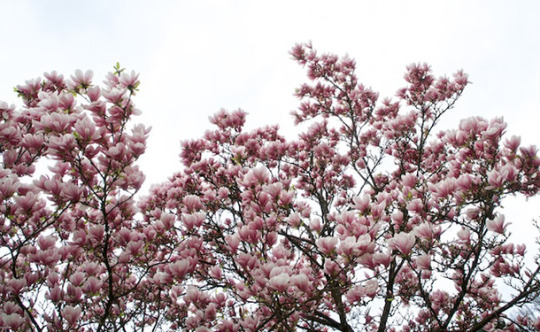
Magnolia Grandiflora trees or Bull Bay are a stunning evergreen species native to the southeastern United States. They are known for their immense, fragrant white flowers blooming in the summer and their glossy, leathery leaves remaining green year-round. They have a moderate growth rate and can reach 60 to 80 feet in height and spread at maturity. They are hardy in USDA zones 7 through 9 and prefer well-drained soil rich in organic matter.
Magnolia Grandiflora trees require minimal care and maintenance once established. They prefer full sun to partial shade and should be watered regularly. They do not require fertilization, but occasional pruning will help maintain their shape and promote healthy new growth. Magnolia Grandiflora trees are highly valued for their ornamental beauty and are often used as specimen trees in landscaping.
5. Black Walnut (Juglans nigra)
[caption id="attachment_693" align="aligncenter" width="610"]

Photo by Sue Lowndes[/caption]
Black walnut trees, or Juglans nigra, are a large and long-lived species native to eastern North America. They are known for their valuable wood and edible nuts, which have a distinctly rich buttery flavor. They have a moderate to fast growth rate and can reach 70 to 100 feet with a 50 to 75-foot spread at maturity. They are hardy in USDA zones 4 through 9 and prefer well-drained, moderately fertile soil.
Black walnut trees require minimal care and maintenance once established. This tree species prefers full sun to partial shade and should be watered regularly. They benefit from an annual compost or organic fertilizer application around the tree’s base. Pruning is typically only necessary for dead or diseased branch removal. Black walnut trees are highly valued for their wood, used for furniture, flooring, and other applications.
Large Trees for Vast Landscapes
In this article, you discovered species, growing, and care information for some of Zone 7’s largest tree varieties for your vast, empty landscape.
Identifying larger trees to help you add dimension and interest to your landscape will give you more shaded areas and potentially increase your home’s curb appeal.
Without larger trees in your landscape, you will have excess barren areas unprotected from the sun’s harsh rays and violent weather.
Sources:
trees.umn.edu/weeping-willow-salix-alba
snr.unl.edu/data/trees/identification/basictree.aspx?sid=65
uky.edu/hort/American-Beech
plants.ces.ncsu.edu/plants/magnolia-grandiflora/
nfs.unl.edu/woody-plants/black-walnut
For the original version of this article visit: https://www.thetreecareguide.com/large-trees-for-zone-7-landscapes/
0 notes
Text
Choosing a 7B Landscape Tree for Your Marietta Yard

Need help selecting the best tree for your Hardiness zone 7b yard? Understanding different tree species’ characteristics and growing habits will help you plant a tree that fits perfectly in your yard.
toddsmariettatreeservices.com gathered the following tree species and growing information for zone 7b landscape trees.
What is a Landscaping Tree?
Landscaping trees are planted to create diversity and serve one of many purposes on your property. These trees come in all shapes and sizes and can be among the most significant assets to your yard by providing shade, privacy screens, wind protection, wildlife refuge, visual interest (curb appeal), and other uses.
What are the Benefits of Landscape Trees?
Landscape trees reduce air pollution and noise pollution. They also filter water and absorb rainfall, lessening the impact of flood and stormwater and preventing soil erosion. Trees also attract a variety of birds and natural wildlife, providing food and shelter.
Note: A large, healthy tree can absorb approximately 40,000 gallons of groundwater annually, returning it to the atmosphere through evapotranspiration.
What are the Best Trees for Your Front Yard?
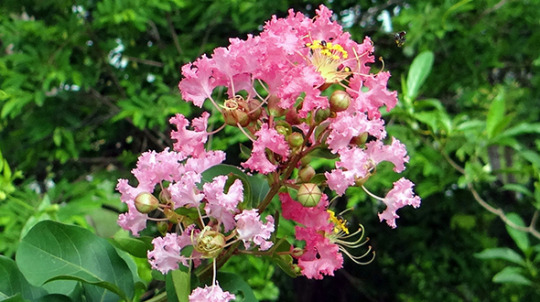
Flowers add pops of color, and mulch creates a clean, well-manicured look. With trees, you can balance height and width in your landscape. Trees are among the best ways to draw the eye, add height, and create a relaxing balance. Curb appeal helps sell a home (trees significantly contribute to curb appeal), and here are a few of the best front yard trees:
Crepe Myrtle (Lagerstroemia) reaches 15 feet
Blue Spruce (Picea pungens) reaches 75 feet
Cherry (Prunus avium) reaches 25 to 30 feet
River Birch (Betula nigra) reaches 60 to 70 feet
Magnolia (Magnolia) reaches 70 to 80 feet
Tip: Avoid catastrophic structural damages by planting your trees at a safe distance from structures on your landscape.
What are the Most Low-Maintenance Landscape Trees?

Once you have determined your tree’s purpose in your landscape (flowers, evergreen shade, privacy, etc.), you should consider the tree’s maintenance. Some landscape plants drop fruit and nuts, while others grow with invasive or surface roots, disturbing your yard, driveway, and foundation. Consider the following low-maintenance landscape trees:
Japanese Maple (Acer palmatum) reaches 25 to 35 feet with delicate branches and vibrant foliage
Jacaranda (Jacaranda) reaches 25 to 40 feet with striking blue and lavender flowers
Redbud (Cercis) reaches 10 to 20 feet with deep red, bright yellow, or two-colored foliage
Frangipani (Plumeria) reaches 20 to 25 feet with non-invasive roots and an abundance of beautiful flowers
Cherry Plum (Prunus cerasifera) reaches 25 feet with deep purple foliage and pink/white flowers
Tip: All tree species require seasonal pruning and thorough inspection after severe weather.
What are the Best Trees to Plant Near a House?

Smaller trees with shallow or non-invasive roots pose little or no risk to your home. Consider the following low-risk tree species:
Weeping Willow (Salix babylonica) reaches 30 to 40 feet
Paper Birch (Betula papyrifera) reaches 50 to 70 feet
Silver Maple (Acer saccharinum) reaches 50 to 80 feet
Sweetgum (Liquidambar) reaches 60 to 75 feet
Crabapple (Malus) reaches 15 to 20 feet
Tip: Towering tree species like southern pines and eucalyptus should be given extra space and not planted within 40 to 50 feet of landscape structures.
Why do Landscape Designers Prefer Male Trees?
Trees with male reproductive organs are preferred in landscapes because they don’t drop messy seed pods or fruit. However, they do produce and release pollen.
Note: When female trees, which capture pollen, are absent from significant landscape areas, the entire area can be blanketed by mass amounts of pollen.
What is the Best Pine Tree to Plant in Zone 7b?
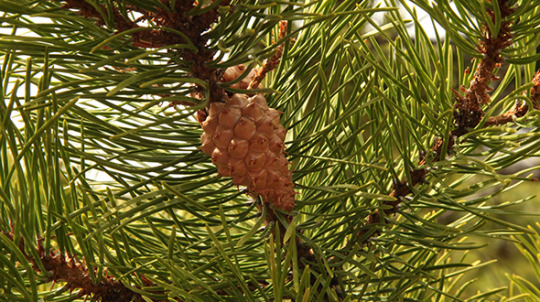
Pine trees are often used in landscapes as privacy screens and specimen trees because they are fast-growing, shapely, and evergreen. Consider the following pine tree species for your landscape needs:
Loblolly Pine (Pinus taeda) reaches 60 to 90 feet
Austrian or Black Pine (Pinus nigra) reaches 50 to 60 feet and requires ample space to flourish
Lodgepole Pine (Pinus contorta) reaches 70 to 80 feet
Red Pine (Pinus resinosa) reaches 50 to 80 feet
Eastern White Pine (Pinus strobus) reaches 50 to 80 feet
Tip: Avoid planting pines near driveways and carports (overhanging branches can leave your vehicle or structure riddled with sap droppings). Pine trees produce and drip sap. The sap flow is heaviest in spring and early summer. During winter, sap slows down and picks up again as spring approaches.
Marietta Georgia Zone 7b Landscape Trees
In this article, you discovered species information and growing characteristics for several popular zone 7b landscape trees.
Knowing which trees to plant around your home and landscape will help you create a beautiful yard with purpose and elevated curb appeal.
Planting the wrong tree species in the wrong location can result in catastrophic root damage to your landscape, driveway, pathway, foundation, and home if it falls on your roof.
Sources:
usgs.gov/special-topics/water-science-school/science/evapotranspiration-and-water-cycle#overview
extension.tennessee.edu/publications/Documents/SP517.pdf
extension.uga.edu/publications/detail.html?number=b625#title11
uaex.uada.edu/publications/pdf/FSA-6126.pdf
Todd’s Marietta Tree Services
Marietta, GA
(678) 505-0266
For the original version of this article visit: https://www.toddsmariettatreeservices.com/choosing-a-7b-landscape-tree-for-your-marietta-yard/
#Landscape Tree#USDA Hardiness Zone 7B#Zone 7B#Marietta Landscape#Tree Service Marietta Ga#Emergency Tree Removal Marietta Ga
1 note
·
View note
Text
for people who can't click into the article right now, this is about the standard plant hardiness zone chart all people who garden in america are familiar with, and the way it has shifted the as climate change ramps up.
628 notes
·
View notes
Text
Create Your Own Soil Profile!
A garden’s soil is the base of all its growth, and knowing how to properly interact with your soil can make all the difference!
Step 1 Site Observations
Take a few photos of your site (project area)
Note down:
what vegetation is there?
is it near water?
the slope
approximate exposure to sun
Step 2 Take a soil profile
Set out a tarp or a garbage bag
Dig a hole about 3 feet deep (you may want a friend’s help!)
Place that soil in piles onto the tarp, sorted into different soil layers
Remember horizons! (O, A, E, B, C, R(bedrock))
Make a sketch of a soil profile, and measure the depth of each horizon
The top of the profile should start with 0 cm
Refill the hole, and try to return each type of soil in order!
Step 3 Build your profile
Describe each layer of soil, moisture/structure/color/smell

Use the “feel” method to take notes

Step 4 Drainage
Dig a hole 1 foot deep and 1 foot wide(ish)
Fill the hole with water and measure how long it takes to fully drain
An ideal time is around 10 to 30 minutes!
Note down the time
Keep in mind that even if the soil type would suit desert-like plants more, think of the weather. If it rains a good deal the drainage can matter less(or more!)
Step 5 Biological Activity
Bury a pair of cotton underwear(I know it’s silly)
Wait about 60 days
Unearth the undies, the more tattered they are the more activity there is!
Step 6 pH Testing
OSU Lab for Oregon, and many states have soil testing labs
Soil pH Meter
DIY Test
Step 7 Hardiness Zone
This just takes looking at a map!
Hardiness zones can tell you about the weather’s highs & lows in a particular area
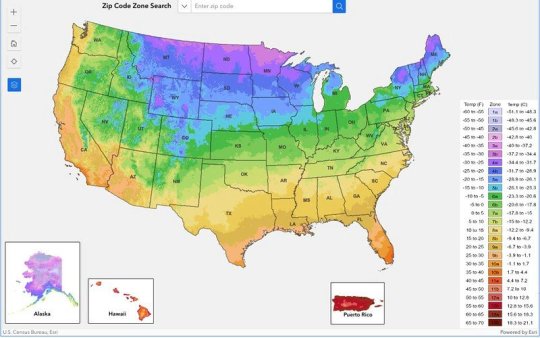
USDA Plant Hardiness Map
And that 's it! It's a lot, and you don’t have to do everything. Each step can provide a better view of how to properly support your garden, and can be fun activities to do with friends and family!
I’ve included a template for a complete soil profile, but feel free to make them as fancy as y’all want!
Sincerely,
records of dirt
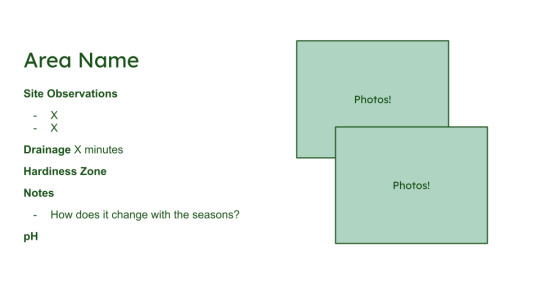

393 notes
·
View notes
Text
food & agriculture in fallout: extrapolation and speculative worldbuilding
Okay, well. This is going to be an extremely long and data heavy post. Bear with me.
I'm going to go into detail about the crops and available food given to us canonically and textually. I'm going to be drawing some real world parallels between the crops we see in Fallout and what we have here. I'll be pulling relevant data from all the games, but the majority focus on this post is going to be about the east coast and Massachusetts in particular because it gives us the opportunity to participate in the agricultural climate of the wasteland.
Is there a point to this? Not really, but I'm pedantic and I take things too seriously.
my sources will be linked in the text throughout. for those of you who want to read about agricultural and growing zones of the continental united states, please follow me under the cut.
Growing zones and real world agriculture
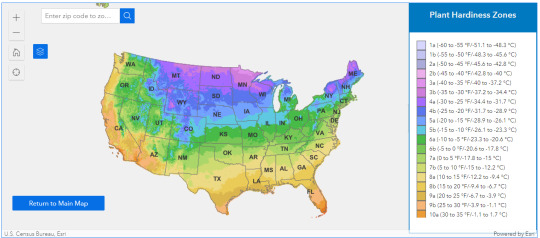
Shown here are the growing zones of the united states, divided into a temperature map of about 19 different regions. It's fairly intuitive to read -- colder temperatures are north and east, while warmer temperatures are south and west. The majority of the Mojave desert sits between 7a to 9a, a temperature range of about 20 degrees. DC and the nearby section of the southeast coast sits between 7a and 8a. The interactive map linked below will tell you where your growing zone sits.
The 2012 USDA Plant Hardiness Zone Map is the standard by which gardeners and growers can determine which plants are most likely to thrive at a location. The map is based on the average annual minimum winter temperature, divided into 10-degree F zones and further divided into 5-degree F half-zones.
For the moment, we are going to focus on Massachusetts.

Using the temperature above, we can see that the growing zone of Massachusetts is 5a (-20f) at it's very coldest, all the way to 7b, (5f) at it's warmest during winter. Most of what we see in fallout 5 sits in the 6a to 6b zone, which is middle ground during the winter, but cold enough to want to warrant crops that can withstand the frost.
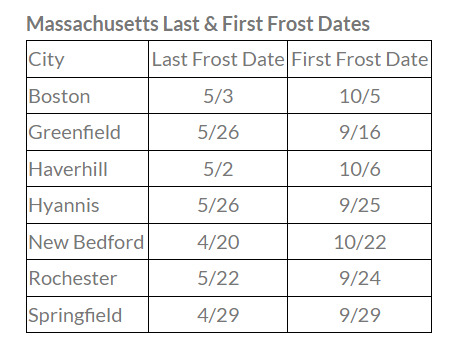
There is a solid 5 month window for planting annual crops, like corn, melons, and gourds like pumpkin. Your perennial crops are limited to fruit trees and possibly grains, depending on the variety and whether or not a perennial variety has been bred.
Cold weather crops include beets, carrots, greens like cabbage, collards, kale, and potatoes. These aren't the types of crops that will survive the winter as much as these are foods that can go in the ground as soon as it is unfrozen enough to be workable. Root vegetables and greens can germinate in soil as cold as 40 degrees Fahrenheit, which provides some leeway with unpredictable frosts and late planting times.
Much of the agricultural landscape of Massachusetts is dependent on the dairy industry, farming cattle, and aquaculture -- fishing and catching shellfish. Those with access to the coasts, fish and shellfish ought to provide protein during lean months.
Why are we talking about this? Well, if we're stepping into the shoes of a subsistence farmer in the fallout universe, we're going to have to take into account climate and ideal planting times for certain crops. It's not wholly important in terms of things like fic writing, unless you happen to be writing about the life and times of wasteland agriculture, in which case, I hope this is helpful! Again, I am pedantic, and this section is to provide a template when considering and discussing other parts of the game and what their specific diet and agricultural landscapes might look like.
Something to keep in mind when thinking about how farms might function in the Mojave, for instance, or if you're doing worldbuilding for a different part of the US.
Crops in the fallout universe
Now that we're familiar with growing zones and why certain crops are planted and when, we're going to apply some speculative worldbuilding to fallout itself. We will be revisiting growing zones when we talk about other climates, but for the moment, we're going to focus on fallout 4.
Now to preface -- I don't think that the food that is given to us in game is wholly representative of the plants or animals that survived the apocalypse. If some managed to mutant and survive, I'm willing to bet others did. I certainly won't deduct any points from anyone who wants to talk about growing cotton, or farming peaches or cherries, and I won't raise any eyebrows if someone includes things like spices into their wasteland cuisine.
In the 210+ years since the bombs fell, I do not think that the majority of the US is a desolate wasteland, but this post is not going to be my beef with the devs about how brown everything is. This beef is about food in particular. However, for sake of ease, I'm mostly just going to focus on the food that is presented to us in game.
There will be some extrapolation and speculation later, but if I do that for everything, then we'll be here all day, and we've all got things to do.
I would also be remiss to mention that agriculture in the US is old. It predates colonialism. The Native Americans cultivated the land long before any European settlers. They practiced a type of crop growing referred to as Three Sisters planting, which utilized corn, pole beans, and squash -- all things that exist in the agricultural landscape of Fallout as we know it.
Corn
I'm not going to say much about corn because there's not a lot to say about it. We all know what corn is. Fallout's corn is visually similar to wild violet, a hybrid corn.

But I am not going to say Fallout's corn is one such variety or another. In the 210 years since the bombs dropped, I imagine corn varietals have been bred and interbred a thousand times, and it is probably it's own unique strain. It's kind of a moot point. Corn is corn. You can do with yellow corn what you can do with wild violet, and whatever special breeds that make up Fallout's corn.
Corn is the third largest plant-based food source in the world. Despite its importance as a major food in many parts of the world, corn is inferior to other cereals in nutritional value. Its protein is of poor quality, and it is deficient in niacin. Diets in which it predominates often result in pellagra (niacin-deficiency disease). Corn is high in dietary fibre and rich in antioxidants.
You can do a shit ton with corn. It's a staple grain. It would not be incongruous with the fallout setting to have settlers making tortillas, cornbread, polenta, grits, tamales, etc. Corn can also be used to make corn whiskey. The husks can be spun into yarn and woven into garments similar to cotton, which I thought was interesting and also solves the problem of where the hell wastelanders are getting their clothes. Corn can be used as livestock feed, especially in the winter when cattle can't graze. While corn is a staple grain of the US, the east coast has minor corn production compared to places like the midwest. Corn is a staple, but it does not consist of the entire diet of your average wastelander.
Carrots
Not going to say much about carrots either. They're carrots. They grow well in colder soil and tend to have a lot of natural sugars. The carrots we're shown in FO4 seem to be a mutated variety different than the "fresh carrot" consumable in FNV, but there's virtually no difference, so I'm not counting it. Make some carrot cake.
Razorgrain
"This species appears to be quite promising. It's a toothy grain that we may be able to grind in order to replace wheat, which is untenable in the Wasteland. We are uncertain how to increase crop yields, which are very unpredictable. Will continue to study."
Razorgrain is our first unique mutated crop in the fallout setting. It most closely resembles a barley or a rye. Both are a fairly hardy species and can grow all across the continental united states; rye can germinate in cold weather temperatures. It wouldn't be outrageous to assume that razorgrain is similar too or a crossbred variation of both rye and barley. I have decided to base the majority of my research assuming it is a barley variant. Barley is also a major crop on the east coast near the Commonwealth, so that would explain why razorgrain is present in FO4 and not in the other games.
Barley requires a mild winter climate and can grow in growing zones 3-8, so it would be viable in Massachusetts. Barley can be milled into flour and it contains gluten; the gluten content of North American wheat and barley tends to be higher to survive the colder climates, so razorgrain would likely be very glutenous. It is also less susceptible to ergot than rye, but barley can still become infected -- and, I am assuming, razorgrain could as well.
Razorgrain fills the nutritional niche of carbohydrates and can be used to make breads, cakes, pastas, etc. It produces darker breads that have an earthier flavor than milled white flour. There has to be some method of actually milling the grain, though, which is an intensive process that can often be dangerous. Grain can also be used to make malted candy, which is our first option for wastelanders with a sweet tooth. Obviously, razorgrain can also be used to make malt or grain alcohol and is probably the source of all the beer you find littered around the wasteland.
Gourds and melons
Gourds and melons are actually a part of the same family, Cucurbita. The category of 'gourd' covers several different kinds of vegetables, including ornamental fruits that shouldn't be eaten. We aren't going to spend a whole lot of time on this one, simply because canon doesn't tell us that much and there's a lot of wiggle room in terms of interpretation.

FO4's model looks the most similar to a pumpkin, but it could be some other squash varietal from the Cucurbita family, which includes watermelon, honey melon, cucumber, squash, zucchini and pumpkin.
Melons is another pretty broad category. Melons and squash are part of the same family, as mentioned above. If we're going visuals again, the model is likely intended to resemble a watermelon. Watermelons grow best in humid and semi-arid environments between 70 and 8- degrees Fahrenheit. It's not impossible for wastelanders to be growing watermelons, but considering the humidity and frequent rainfall in Massachusetts, the melons would be vulnerable to fungal infections.
There isn't a lot of information on what specifically gourds and melons are in the fallout universe, so you could get away with writing in a pretty wide variety. Personally, I lean a little bit towards melons being a muskmelon variety, like cantaloupe or honeydew. Squash fills in some vitamin requirements for the human diet, and can be canned and stored for winter. It tends to be high in vitamin C and magnesium.
The limit to this one seems to be your imagination. Go crazy.
Mutfruit
This wiki claims that the mutfruit (it has a scientific name apparently, malus maata) is a mutated species of apple and crabapple. There are two different wikis about the mutfruit, both distinct. The first is linked above. The second is linked here -- I got most of my information from this second wiki.
There is a handful of "canon" information we can take from this set of wikis.
Priscilla Penske in Vault 81 is attempting to create foods that have increased resistance to radiation. She mentions the mutfruit would do well, but isn't certain how the hybridization would affect the flavor and texture.[5]
This claim is taken directly from the second wiki, but in comparison, it makes no sense. If the mutfruit tree is a product of mutation, then radiation shouldn't really affect it at all. It's survived and propagated to this point, hasn't it? I am disregarding this claim on the basis of being stupid.
Farmers in at Warwick homestead will comment on the fruit's characteristics, such as tasting sweet and being versatile in recipes.[1][2]
The vault dwellers of Vault 81 trade for mutfruit with the outside world, and use it to make special occasion desserts such as pie.[6][7]
If the mutfruit is an apple variant, then it likely has a high sugar content, and it would have to be harvested in the peak of summer or in early fall.
There are fresh apples the be found across the wasteland, implying the existence of apple trees that have been unaffected by the bombs. Personally, I was assuming that the mutfruit was some kind of blackberry, given its appearance as a clustered fruit, or maybe even a type of plum. Regardless, the mutfruit is a fruit, which means that it would preserve well by being jarred or canned, has a high sugar content, and could likely be reduced to form sugar syrups. Like any fruit, it could be used to make alcohol.
Tatos
I want to stop myself from editorializing too much, but goddamn tatos. The crop that makes the least goddamn sense in the fallout universe. The bane of my existence. Let's get into it.
First off, we're given some pretty damning canon facts about tatos:
Tatos are a mutated hybrid of the cross-pollination of the tomato and potato plants.[1] The new consumable looks like a tomato on the outside, but the inside is brown.[2] Commonly cultivated in the Commonwealth, Appalachia and on the Island, its fruit is easy to grow and can keep one from starving, but their taste is described as "disgusting"[2][3][Non-game 1] and resembling "ketchup-flavored cardboard."[1]
According to some old botany texts we found, this appears to be combination of a now extinct plant called a "potato" and another extinct plant called a "tomato." The outside looks like a tomato, but the inside is brown. Tastes as absolutely disgusting as it looks, but will keep you from starving.
Note: This text was written from the perspective of someone who is unaware that both the tomato and the potato are being cultivated elsewhere. The writer also does not mention any sort of DNA test. However, the potato is also found in the Capital Wasteland, and the writer is a scribe in the Brotherhood of Steel, which originated from that area.
Both potatoes and tomatoes are from the nightshade family. They have the same nutrient requirements, and would compete for resources if planted separately but in the same soil. There is a method for planting them together where you splice a tomato stalk onto a potato root, but this is not the same as cross pollination and will not result in what fallout presents as a tato. What will happen is that the roots will grow potatoes and the fruit of the tomato will branch off the stems.
The potato itself is a stem tuber -- high in starch and calorically dense. A stem tuber is an offshoot of the parent plant that will grow beneath the soil as a type of asexual budding reproduction. We all know what a potato is. The tomato is a berry. It's the ovary of a flowering plant -- again, we all know what a tomato is.
I am going to give Fallout a little bit of grace and not comment on how mind bendingly stupid their description of a tato is. The outer skin is a tomato, but the inside is brown and starchy like the potato? I am not going to comment on how it makes little to no biological sense. The starchy tuber is starchy because it's an energy and nutrient storage device. The tomato is the enlarged ovary of a fruit. Why did those things, which are separately very good, combine into one very terrible thing? I don't know. It doesn't make sense. I don't really want to think about it. But these are the facts as they are given to us in game and I suppose I have to live with that. Obligatory "goddamn you todd howard. a pox on your house."
The tato is probably extremely calorically dense. It's specifically mentioned as being easy to grow and it is a better alternative to starving. It's probably grown as a staple crop throughout the planting season. I'm not entirely sure if the tato can produce glycoalkaloids like the potato does (that is, the green sections of the potato that can become poisonous when exposed to light) but if they can, and if stored improperly, it would negatively impact the health of whoever ate them.
I suppose since the taste is so offensive, tatos are better served as a carrier of some other type of food. Fried, mashed, baked -- the purpose of the tato is simply to get calories into your body. Starch can also be turned into alcohol, which I am going to need a lot of after reading the canonical facts of this stupid fucking plant.
Fallout: The Roleplaying Game Rulebook p.158: "A mutated hybrid of the pre-War tomato and potato plants, with the stem and reddish skin of the former and the brownish flesh of the latter. Tatos provide decent nutrition, but taste disgusting. However, they’re relatively easy to grow and thus are a staple of wasteland agriculture and is an ingredient in a variety of recipes."
fucker
"non farmable" crops
You can't cultivate these plants, but again - we're taking what's given to us and interpreting it extremely literally. There is no reason that these crops could not be domesticated and farmed.
Siltbean
Siltbean is likely a type of bushbean, rather than a pole bean. It's squat and low to the ground. Bush beans require little care or attention and you can pick them when you're ready to harvest them. Historically in North America, beans and corn were grown side by side (though those beans were pole beans using the stalks as support). Bush beans require successive plantings since harvests are early.
There's no good allegory for what type of bean this might be. The potato bean (Apios americana) is native to North America and also produces edible tubers, but there's no reason this couldn't be just some other type of bean. No beans that I could find had red/orange pods.

Beans are a good source of both proteins and carbohydrates, and another crop that can store well for the winter.
Tarberry
Tarberry is a little iffy, considering it is farmed by the ghouls at The Slog, but they're the only farm shown capable (or willing?) to farm the berries. Originally, I had assumed that tarberries were a type of mutated cranberry, and I thought the wiki was supporting me in that claim by saying this:
Tarberries are small, dusty orange berries of the tarberry plant. It is a water-grown crop similar to cranberries.
But cranberries themselves are also canon in the world of Fallout. So who knows! There's no canon information presented on the tarberry's characteristics, so it can be treated the same as any other fruit or berry.
Fungus variants
Glowing fungus: Glowing fungus is one of the few real world equivalents we have. It is a Japanese mushroom called Enoki. It is also farmable as shown in FNV at Hell's Motel.
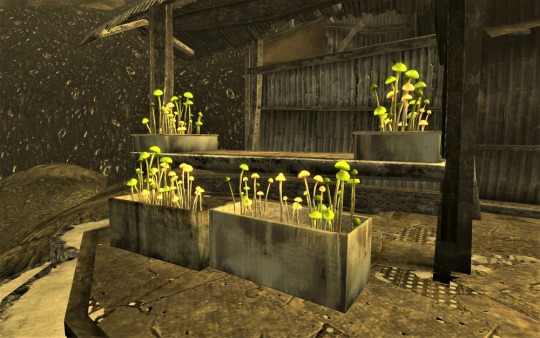
Brain fungus: This is harvestable, but there aren't any "crops" shown as we would consider them. Considering it's benefits as a mentat replacement, then it's likely that there could be a dedicated space for growing it.
Food and Plants mentioned in the text
Potato
Thank god almighty, potatoes are canon in the universe of Fallout. Fresh potatoes are found as consumables in FO3 and FNV but potatoes are also mentioned in the text of FO4:
Mentioned in dialogue -- {Angry} Shut up Jake. If I hear anything out of either of you, you'll both be peeling potatoes for the next year.
I'm taking this as word of god. Potatoes are canon and I don't care what anyone says.
Tomato
Tomatoes are mentioned in the text, but are never actually seen in game. The only hint that this plant survived extinction is this excerpt from the wiki.
Note: As fresh tomatoes and potatoes are seen in the Mojave Wasteland as of 2281, with the potato seen in the Capital Wasteland as of 2277, the claim of either's extinction by 2287 in the Commonwealth Plant Database could be taken to mean local extinction in east coast regions, as opposed to global extinction. This entry may also just be in error.
There's potential for leeway here, but take it as you will!
Fresh apple
We discussed this back up in the mutfruit section of the essay, but the existence of fresh apples implies the existence of non mutated apple trees. They're found in both FO3 and FNV as a consumable item, so the apple tress have either proliferated across the continental united states, or multiple varieties survived the bombs.
Fresh pear
See above. Pears are also naturally high in pectin, which makes them useful for making jams and preserves.
Pinto beans
Pinto beans are a consumable in FNV and is another W in the bean category of the agricultural landscape.
Jalepeno
Look, I'm picking out this one specifically because I need to believe that other spices and peppers exist in the world. Where would we be without her? Nowhere good.
Raw sap
I am going to say that sap collecting is probably where most of the sugars and sweeteners in the wasteland come from. It's relatively easy to tap trees and collect sap, and it only takes a few hours to reduce the sap down into useable syrup.
Wild Blackberry, Lime, Cranberries, as well as Watermelon as being distinct from simply 'melon' are all mentioned in the text. The list of fruits mentioned or found in the games can be found here.
Animal husbandry
Fallout doesn't give us a lot of canonical information on the animal side of farming. The biggest real world agricultural export of Massachusetts is dairy and cattle farming. Chickens are canon in the worldbuilding of fallout as of Far Harbor, but canon feels both restrictive and extremely loose with regards to what animals can be cared for and how.
We aren't going to spend a whole lot of time on this one, only because the information is pretty limited.
Brahmin
There are plenty of brahmin found throughout the landscape of the wasteland. We most commonly see them as either livestock or beasts of burden. Things like milk, cheese, and other dairy products would be common if a farm has access to dairy cows. The investment to raise cows would be enormous for a subsistence farmer. Dairy cows would likely be kept for a number of years, where steers would be raised 12 to 24 months before being slaughtered; they'd likely be grass fed in the summer and corn or grain fed in the winter. Leather and beef would be products, of course, and things like soap and candles can be made from the beef tallow.
Chickens
Chickens are largely easy to keep and care for, producing eggs and necessary proteins. Chickens can provide niacin, filling in the nutritional gap that would be left by a heavy corn based diet. The investment for keeping chickens is lower than raising brahmin, but so is the payoff.
Bighorners
Bighorners are mutated bighorn sheep native to the American Southwest.[1] Humans have since domesticated them for their horns, meat, milk, and hides,[2][3]
Granted, bighorners are only seen in FNV, but I don't think there's any reason they couldn't have migrated east. In the text, it says they're kept for meat and milk, but there's no reason that they shouldn't provide a fleece as well. In the colder climate of Massachusetts, they would find value in wool, which can keep its warmth even when wet. They may be sparse across the commonwealth, but that would make wool and fleece all that much more valuable.
Fish
Yeah, I know. Technically we can't fish in Fallout (and depending on the game you play, you might not even know what a fish is). But aquaculture is huge in Boston, and with access to the coasts, it's completely fair to say that fish, shellfish, and hydroponics is a completely viable source of food in the wasteland. We see dead fish washed up on shore all the time, along with whatever the hell those shark things are. There should be fisheries and fishing towns all along the coasts.
New Vegas and Fallout 3
Consulting our growing zone chart, we can see that much of the southwest sits between 7b to 8b. The winters in the southwest are fairly mild, and while you can get seeds in the ground sooner, the majority of the battle is going to be finding a reliable water source.
The farming we see in New Vegas has one distinct notable inclusion: the NCR sharecropper farm.
The sharecroppers are growing a number of crops, including maize, tobacco, pinto beans, and honey mesquite. Corn can handle hot, arid weather, it's just not commercially grown out west. Barley can also handle hot, arid climates, and razorgrain would be suitable for the western front -- maybe we can assume it's made it's way that far west and is being cultivated alongside corn.
Most of the plants we see in FNV aren't the type we would see typically domesticated for agricultural use, but that doesn't mean people haven't adapted to their surroundings. It makes a lot of sense for locals to have domesticated local plants like prickly pear and banana yucca. There are a number of fresh produce items to be found as consumables, alongside local fruits the local fruits.
Heat-loving plants are best suited for summer production in desert climates. The plant families that fit into the heat-loving category are nightshade or Solanaceae (tomatoes, peppers, eggplant) and squash or Cucurbitaceae (cucumbers, melons, summer and winter squash). Corn and beans also perform best in hot climates.
Most plants CAN handle the heat and climate of the southwest, the issue is just finding a reliable source of water. Somewhere close to Lake Mead or the banks of the Virgin River would be prime real estate for farming, since irrigation could be accomplished without the use of pumps, like the sharecroppers use.
If we look back at the history of agriculture, it's developed along established waterways in almost every ancient civilization because that's what's easiest. There should be thriving communities surrounding the lakes and rivers in the southwest.
Comparatively, DC was formerly a swamp. It's hot and humid in the summer, though the winters are fairly mild. It wouldn't be a stretch to say that farming practices in the Commonwealth don't differ all that much from farming in the Capital Wasteland -- you could even posit that food from the Capital is of better quality ever since the successful activation of Project Purity. Fresh and unirradiated food was growing there before, so it's entirely likely that even more is growing now. YMMV!
Other consumables
We would be here all damn day if I did research onto every single consumable item available across all three games, so this mostly just because I'm covering my bases.
I am going to say that sap collecting is probably where most of the sugars and sweeteners in the wasteland come from. It's relatively easy to tap trees and collect sap, and it only takes a few hours to reduce the sap down into useable syrup.
Look, I'm picking out this one specifically because I need to believe that other spices and peppers exist in the world. Where would we be without her? Nowhere good.
Pre War food
Most shelf-stable foods are safe indefinitely. In fact, canned goods will last for years, as long as the can itself is in good condition (no rust, dents, or swelling). Packaged foods (cereal, pasta, cookies) will be safe past the ‘best by’ date, although they may eventually become stale or develop an off flavor.
The risk with improperly canned good, or damaged canned goods, is botulism. Botulism will straight up kill you. You don't even have to consume that much of it; just a little bit will leave you dead in days. As desperate as I might be for a meal, I'm not going to risk dying because that can of two hundred year old peaches looks really tasty.
If properly sealed and in a dry, ideal environment, I... guess things like cereal and instant food could be okay? But again, with access to fresh grain, sugars, and yes, even potatoes and pasta, why would you want to risk eating InstaMash that's been around since before your great grandmother.
Pre War drinks
Sigh. Okay.
Unless stored extremely, extremely well, most bottled drinks aren't going to last much longer than 9 months. A year, if you're lucky. Exposure to sunlight and improper storage will break down the contents -- the best bottles are brown, then green. Clear glass is the worst because it does nothing to protect the liquid inside.
All the Nuka Cola you find throughout the world is flat, nasty, and will probably make you sick. I don't think that really needs to be pointed out, but there we go. I suppose the soda could probably be reduced to form sugar syrups, but with access to sap syrup and grain malt, I'm not sure why you would be desperate enough to do that.
So what does food look like in Fallout?
If there's one thing I know about humans, it's that humans like to eat. Food is culture, as much as culture and community is built around food. Good food and access to it is paramount to human happiness. All this to say is that food in fallout is whatever you want it to look like.
I can extrapolate and theorize all day long based on what Fallout tells us definitively, but I'm not going to tell you what the culinary landscape in the wasteland looks like. The only point that I will stress is that humans are really, really good at making things appetizing.
The fandom is already so creative when it comes to developing their idea of what food means in the wasteland. It's what's directly inspired me to write up this stupid, long ass post about farming and agriculture.
Obviously this is not a comprehensive list of all the base ingredients you can find in Fallout. I picked the ones I did because of the potential for consistent farming. Wastelanders have had two centuries to develop agricultural practices based around subsistence farming. I am not a subsistence farmer, and I have no idea how wasteland cottagecore would work at the heart of it. Running a farm is extremely labor intensive, and so much of your investment has to be immediately recouped in the form of eating what you harvest.
What a farm is likely to look like will start in the early spring when the ground begins to thaw, and a farmer can plant his cold resistant crops, like green vegetables and razorgrain. Potatos, carrots, and tatos will also weather the spring chill. When it starts to warm up, the more delicate plants like corn, beans, and squash or melons will get planted and tended to.
If your family is lucky enough to have a greenhouse, you can keep crops growing all through the winter and have a surplus for trade and barter, or just to preserve and refill the pantries.
A lot of the investment will have to be immediately recouped. Eggs from the chickens can't be preserved, obviously, but there will be meat from hunted animals, milk from the brahmin, probably an early harvest from the beans and tatos, and whatever else is in the pantry from the previous harvest.
Some of it will be canned or preserved in the forms of jams or jellies (just remember what I said about botulism). Meat from animals that get hunted can be smoked or otherwise preserved. Grain can be milled into flour or eaten whole and unshelled. Even the corn silk can be woven into clothes for the summer.
There really is no limit to what can be done in the end. While a lot of this information was taken from what we're given in the text, there's no rule that says you have to follow it word for word. If you believe something exists out there, then write it! We're all just making shit up as we go along anyway. If you need permission, then here it is. You can do whatever you want. Make up recipes! Go insane. Follow whatever your little foodie heart desires.

#fallout#kal talks#fallout 4#fallout new vegas#fnv#fallout 3#fallout meta#fallout food#fallout headcanons#behold. the agricultural masterpost of my farming headcanons#here she is
745 notes
·
View notes
Text
Climate warming in the USA
The USDA just released its new plant hardiness map, the national standard for understanding areas of extreme low temperatures, helping farmers and gardeners know where to best grow which plants:

The last map from 10 years ago:

Overall, the 2023 map is about 2.5° Fahrenheit warmer than the 2012 map across the United States, meaning about half of the country shifted to a warmer 5°F half zone. The central plains and Midwest has warmed the most.
Here at Ad Astra HQ, we've warmed 5-10°F (3-5°C) in the past decade.
analysis on Phys.org: X
USDA source: X
70 notes
·
View notes
Text
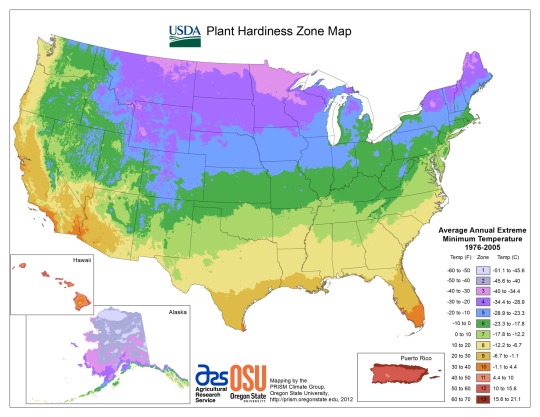
patch notes, because I tried this once before and it didn’t exactly work:
if you want/need to see a more detailed regional map you can do that here
please note: temperatures listed are 30 year averages of minimum temps, not yearly averages
this may not reflect current temps because of climate change
sorry I had to group some zones together but you can only put 10 options down
there isn’t room for a “show results” option. if you can’t vote on this, just don’t??
also, this is US specific because:
I am interested in the correlation between population and climate within the US
these zones are laid out by the United States Department Of Agriculture and as far as I’m aware the USDA is not making climate maps of Europe. make a separate poll if you would like
#hopefully this is Sufficient#climate#polls#maps#geography#marc.txt#was not sure how to address puerto rico being on here sorry#puerto ricans if you would like to contribute please feel free#sucks so bad that you can’t edit polls I don’t want to have to delete this one if it turns out I overlooked smth Major
149 notes
·
View notes
Text
i thought maybe i should try growing a pomegranate shrub because that’s literally free pomegranate but they only grow in usda hardinesss zones 7-10 and i live in usda hardiness zone 6a. Why must life be so hard for a bitch who simply wants a goddamn motherfucking SNACK
40 notes
·
View notes
Text
Isekai Problems: Planting Roots
So what zones are your characters in?
Here I’m referring to the USDA plant hardiness zones for growing regions. There are similar maps for Europe; I saw one in a book on heritage roses once. So I’d guess other areas have made them as well. But the USDA’s the one I know best. It’s also the one I feel personally frustrated by, because I know it best.
Long story short. Hardiness zones are determined by the minimum temperatures the area reaches; you find Zone 1 and 2 up in inner Alaska, you find subtropical to tropical 9 and 10 in bits of Florida, Louisiana, and Texas. Plants can also be sorted by how heat tolerant they are, but freezing to death is a pretty good measure of where a plant can’t make it. If you look at a package of seeds marketed in the U.S., you’ll find the Hardiness Zone map on the back, often with suggested planting times.
However. Local weather patterns can make zones tricky.
Remember how I pointed out zone 9 in Florida? In fact, the Hardiness Zone map shows near the entire Gulf Coast as zone 9. If you look on a larger-scale and more finely detailed map, most of the near-shore will show up as zone 9a - not as warm as, say, central Florida at 9b.
Except that every two to three years there tends to be at least one hard freeze (temps dropping overnight below about 15 F), making the area technically zone 8b. So unless you’re lucky and have cut back and wrapped tender plants, all your banana trees and citrus go bye-bye.
And yet, because it’s not that cold every year, tulips and apple trees - any plants that need some cold dormancy - are likely to keel over too.
All of which means introducing new plants is always a roll of the dice. Can they take the cold and the heat?
If you’re going to introduce new crops, as characters sometimes do in isekai, have some idea about what conditions they need, and whether or not your new locale has them. Cochineal is one of the most beautiful, vibrant, colorfast reds in nature. But if you try to introduce it as a crop in, say, Siberia, when the cochineal scale insect lives on the warmth-loving Opuntia cactus... biologists and ecologists will have a sad. Really.
Likewise if you tried to grow Korean stone pines (nutritious seeds! Medicinal compounds!) in the fantasy equivalent of South Florida’s heat and humidity, people will talk.
You may have better luck with more conventional food crops. Rice, corn, wheat, potatoes - all of these have hundreds if not thousands of varieties, adapted for different conditions. There are rice varieties that tolerate salt enough to grow near shorelines, and a slow-growing, slime-shedding variety of ancient corn that hosts its own nitrogen-fixing bacteria; an awesomely useful feature usually only found in legumes. Human ingenuity and diligent searching may turn up or create a variety of a crop that can survive in what would normally be extreme conditions for that plant. But your story will feel more realistic if you make it clear you’re using magic or bioengineering to get oranges to survive in arctic tundra, or lingonberries in the Sahara. People have an idea of where plants flourish; putting them out of place without a good explanation dents suspension of disbelief.
Of course, temperature’s not the only consideration. Rainfall, soil minerals; is the earth acid or basic, sandy or heavy clay? All of these and more play a part. You don’t have to be an agronomist. Just check out some real-life analogues to what you’re working with to get ideas of what your characters need to do, and what curveballs you can throw at them.
And for goodness’ sake, if the original tamers of a crop grow it in a specific way that doesn’t use the whole field, don’t automatically assume it’s inefficient and you can do it better. Of such decisions are potato famines made....
11 notes
·
View notes
Text
The 2023 U.S. Department of Agriculture's "plant hardiness zone map" is about 2.5 degrees Fahrenheit warmer than the 2012 map across the contiguous U.S.
12 notes
·
View notes
Text
Vanilla Strawberry Hydrangeas ׂׂૢ་༘࿐

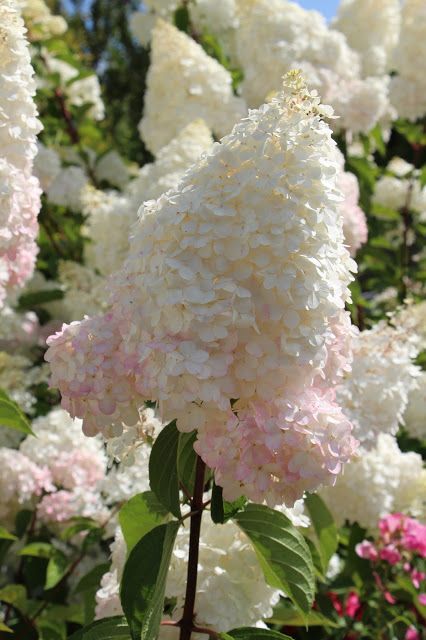
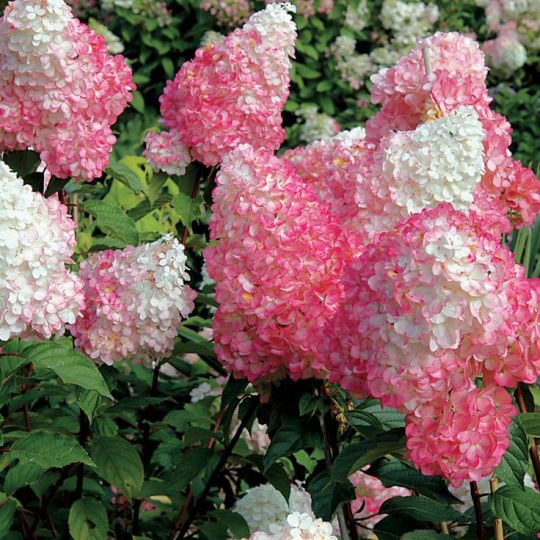

About :
A variation of Hydrangea Paniculata
♡ A beautiful and popular flower voted as the top plant of 2010 by the American Nursery and Landscaping Association, a flower perfect for anything, from a private home garden to wedding floral arrangements.
♡ Very similar to the “Pinky Winky” variation, it blooms white cones in the summer and then pink to eventually red during late summer/early fall as you can see in the pictures above. The main difference is that Pinky Winky is extremely cold hardy.
♡ If you love bees, butterflies, and hummingbirds but don’t want to go through the trouble of planting various amounts of flowers in your yard to attract them, then these vanilla strawberry hydrangeas are perfect for you. They attract all the right things and are low maintenance.
How to grow :
The best time to plant these beautiful flowers is either in spring or late fall. Moist and well-drained soil is key and full to partial sun is needed. Make sure they get 4 to 6 hours of sunlight a day. If you use a water-soluble fertilizer, use it every few weeks, or if you use a slow-release fertilizer then use it every few months. Look for a fertilizer with high levels of phosphorus, they work best.
Extra info :
Watering: Average
Tolerates: Heat
Mature Height: 6 - 7 Feet
USDA Hardiness Zones: 4 - 8
Click this link for more information and message me if you have any questions! ♡
#garden#gardening#flowers#hydrangea#vanilla strawberry hydrangeas#hydrangeas#pink flowers#white flowers#how to grow hydrangeas
5 notes
·
View notes